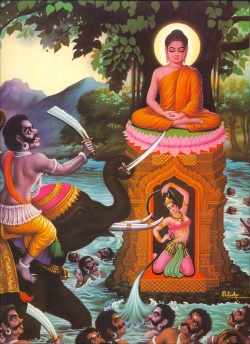Difference between revisions of "Mara"
(Created page with "In theistic religions the Devil, sometimes also known as Satan or Beelzebub, is a being completely opposed to God and to goodness. According to the Tipitaka, the Buddha was ap...") |
|||
| Line 1: | Line 1: | ||
| + | [[File:Buddha15.jpg|thumb|250px|]] | ||
| + | <poem> | ||
In theistic religions the Devil, sometimes also known as Satan or Beelzebub, is a being completely opposed to God and to goodness. According to the Tipitaka, the Buddha was approached on several occasions by a spirit named Mara who tried to stop him from continuing his struggles for enlightenment, to tempt him and to encourage him to die (Sutta Nipata 426; Digha Nikaya 2. 103). Many Buddhists believe that Mara is an actual being while others contend that it is really an allegory or a personification of negative states of mind. There would seem to be more evidence for this second opinion than for the first. This is apparent from the fact that the Pali word màra means ‘death’ or ‘bringing death’ and that Mara’s three offspring are named Lobha, Dosa and Moha, meaning Greed, Hatred and Delusion. This interpretation is further supported by the fact that Buddhism sees evil as thoughts, speech and action motivated by ignorance rather than the machinations of a force external to the human mind. Mara is sometimes also called Kaõha, the Dark One (Majjhima Nikaya 1. 377), or Namuci (Digha Nikaya 2. 259). | In theistic religions the Devil, sometimes also known as Satan or Beelzebub, is a being completely opposed to God and to goodness. According to the Tipitaka, the Buddha was approached on several occasions by a spirit named Mara who tried to stop him from continuing his struggles for enlightenment, to tempt him and to encourage him to die (Sutta Nipata 426; Digha Nikaya 2. 103). Many Buddhists believe that Mara is an actual being while others contend that it is really an allegory or a personification of negative states of mind. There would seem to be more evidence for this second opinion than for the first. This is apparent from the fact that the Pali word màra means ‘death’ or ‘bringing death’ and that Mara’s three offspring are named Lobha, Dosa and Moha, meaning Greed, Hatred and Delusion. This interpretation is further supported by the fact that Buddhism sees evil as thoughts, speech and action motivated by ignorance rather than the machinations of a force external to the human mind. Mara is sometimes also called Kaõha, the Dark One (Majjhima Nikaya 1. 377), or Namuci (Digha Nikaya 2. 259). | ||
| + | |||
| + | Literally: "murder, destruction", the Devil of the Sixth Heaven. Although the embodiment of death, Mara symbolizes in Buddhism the passions that overwhelm human beings as well as everything that hinders the development of wholesome roots and progress on the path of enlightenment." | ||
| + | Literally: "death. The tempter". The personification of evil in Buddhist mythology." | ||
| + | |||
| + | Mara is a Hindu goddess of death. | ||
| + | |||
| + | In Hinduism, Mara brings death (Mrtyu) in the same way that Kama brings love and intimacy. On their own, neither is important, but act more as attributes than as deities. Generally references to Mara as an individual are referenced to Maya Devi (Queen Māyā). | ||
| + | </poem> | ||
{{R}} | {{R}} | ||
[http://www.dhammawiki.com/index.php?title=Mara www.dhammawiki.com] | [http://www.dhammawiki.com/index.php?title=Mara www.dhammawiki.com] | ||
| − | + | [[Category:Buddhist Terms]] | |
| − | [[Category: | ||
| − | |||
[[Category:Buddha Shakyamuni]] | [[Category:Buddha Shakyamuni]] | ||
Revision as of 10:11, 22 May 2013
In theistic religions the Devil, sometimes also known as Satan or Beelzebub, is a being completely opposed to God and to goodness. According to the Tipitaka, the Buddha was approached on several occasions by a spirit named Mara who tried to stop him from continuing his struggles for enlightenment, to tempt him and to encourage him to die (Sutta Nipata 426; Digha Nikaya 2. 103). Many Buddhists believe that Mara is an actual being while others contend that it is really an allegory or a personification of negative states of mind. There would seem to be more evidence for this second opinion than for the first. This is apparent from the fact that the Pali word màra means ‘death’ or ‘bringing death’ and that Mara’s three offspring are named Lobha, Dosa and Moha, meaning Greed, Hatred and Delusion. This interpretation is further supported by the fact that Buddhism sees evil as thoughts, speech and action motivated by ignorance rather than the machinations of a force external to the human mind. Mara is sometimes also called Kaõha, the Dark One (Majjhima Nikaya 1. 377), or Namuci (Digha Nikaya 2. 259).
Literally: "murder, destruction", the Devil of the Sixth Heaven. Although the embodiment of death, Mara symbolizes in Buddhism the passions that overwhelm human beings as well as everything that hinders the development of wholesome roots and progress on the path of enlightenment."
Literally: "death. The tempter". The personification of evil in Buddhist mythology."
Mara is a Hindu goddess of death.
In Hinduism, Mara brings death (Mrtyu) in the same way that Kama brings love and intimacy. On their own, neither is important, but act more as attributes than as deities. Generally references to Mara as an individual are referenced to Maya Devi (Queen Māyā).
